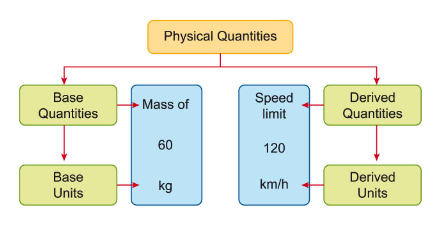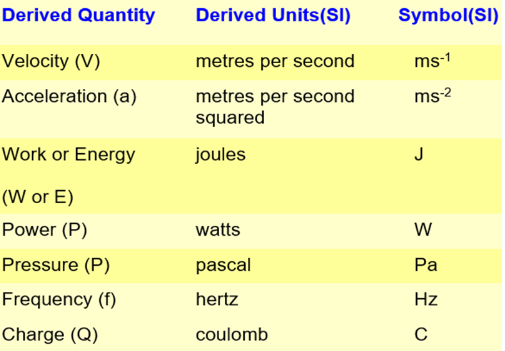1.1 Physical Quantities & SI Units
Those quantities which can be measured are known as physical quantities.
Base Quantities
Those quantities which are based on seven fundamental quantities are known as base quantities.
S.I. units are commonly used by businessmen, scientists and Engineers all over the world.
Base Units
The units of the base quantities are known as base units.
In Physics, all physical quantities are usually measured in the units “known as the SI (System International) units.
The base quantities commonly used in physics are
1) Length is measured in metres (m).
2) Mass is measured in kilograms (kg).
3) Time is measured in seconds (s)
The base quantities commonly used in physics are
1) Length is measured in metres (m).
2) Mass is measured in kilograms (kg).
3) Time is measured in seconds (s)

There are seven base quantities and their units.
All units in science are derived from these base units.
All units in science are derived from these base units.
Rules for Writing Units
If a unit is named after a person or a scientist is always written in a capital letter. (e.g., ampere and A, Newton and N, Kelvin and K, Joule and J etc.).
The names of SI units are always written in lowercase (e.g., metre and “m”, second and “s”, kilogram and “kg’’ Mole and “mol”, etc.)

Derived Units
Those quantities which are made from base quantities are known as derived quantities.
All derived quantities in Physics are made from base quantities.
We use many other units, but all of these are derived units. For example, the unit of area is built from the unit of length.
Area = length × length
m2 = m1 × m1
m2 = m1 × m1
Where metre (m) is a base unit, and square metre (m2) is the derived unit.
Derived Units
Those units which are made from base units are called derived units.
We use many other units, but all of these are derived units. For example, the unit of area is built from the unit of length.
Area = length × length
m2 = m1 × m1
m2 = m1 × m1
Where metre (m) is a base unit, and square metre (m2) is the derived unit.

